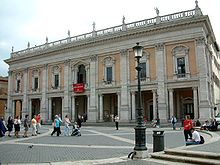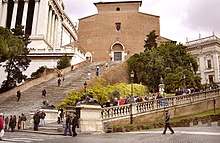Conservators of Rome
The Conservators of Rome or the Camera Capitolina were the three magistrates who, together with the prior of the Caporioni, formed the Roman magistrate between the 13th century and 1870, the year of the end of the popes' secular power.
Sometimes they were also called Conservatores Camerae Alme Urbis or Conservatori del popolo romano . This city magistrate, which represented the executive, was inspired in its functions by the Roman consuls of antiquity.
history
The existence of the conservators has been known since 1223, initially as a replacement for the Senators of Rome ( Conservatores Camere Alme Urbis loco Senatoris ) and lasted uninterrupted until 1866. The office was established after the appointment of senators, who were usually nobles of foreign origin and who did not know the laws and customs of the city. The conservators were therefore responsible for monitoring compliance with and upholding the statutes , especially by the senators themselves, the condition and maintenance of the walls, bridges and streets of the city, the preservation of public monuments with the obligation to raise the funds, as well as for the Granting many other privileges. They represented the head of the city administration of Rome (called Camera Capitolina ) and, due to their functions, were considered heirs to the ancient Roman buildings.
The tasks of the conservators were first explained in the statutes of 1523, for example in the comparison of the monopolies with the statutes.
Their autonomy, which had gradually increased during the Avignon papacy , was severely curtailed after the return to Rome of Pope Martin V Colonna , who in his work to restore ecclesiastical and civil institutions increased their dependence on the Roman Curia : it was not uncommon that the popes themselves appointed the conservators.
Their residence was the palace of the same name in the Piazza del Campidoglio with the adjoining offices and archives of the Roman Senate. The conservators personally received the oath of the new senator from Rome.
They were selected based on lists drawn up by the Caporioni for each of the 14 Rioni , known as Banderesi since 1262 . Together with the Imbussolatori, they drew up the list of eligible persons who were put in a ballot box and in the presence of the main representatives of the community and the Curia in the Basilica of Santa Maria in Aracoeli in Campidoglio, every three months among the main Roman families and then among the 180 nobles, described in the Bull Urbem Romam of 1746, were elected.
eligibility
The election to office was very popular, both because of the considerable compensation and because the election of the elected family automatically received the rank of city nobility or Roman citizen ( patrician ). The election followed a very complex protocol, so that after their election they could only be re-elected after a suspension of at least two terms in office. However, the families who most often boasted of this dignity were mainly those with older roots in the Roman patriciate. Although it allowed the admission of new families to the city positions, the aim was to maintain control of the most important positions in the oldest core of the city. Among the most frequent, in fact, stood out all the Mattei with their various branches, which occupied the Conservatory 23 times between 1500 and 1564 alone, followed by the Altieri, Caffarelli, Capranica, Cenci, Crescenzi , Del Bufalo, Mancini, Santacroce and von der series from various others (Alberini, Albertoni, Arcioni, Astalli, Boccabella, Boccamazza, Boccapaduli, Capizucchi, Capocci, Capodiferro-Maddaleni, Castellani, Cesarini, Fabi, Leni, Maccarani, Margani, Massimo , Mellini, Muti, Naro, Paluzzi, Paoli, Papazzurri, Planca Coronati, Ponziani, Porcari, Sanguigni, Tedallini etc.). This was despite the fact that the Roman nobility was affected by the continuous influx of new families who followed the popes. in some cases, even of foreign origin, was necessarily "open". These families, which formed the class of the city patrician, were originally those whom Paolo Giovio defined as the nobility of the second guard, whose income since the 14th century has been almost exclusively from cattle breeding or the land merchant, customs revenue, trade and the lending of money or the lucrative trade in textiles. This differs from the ten or so families that formed the core of the feudal aristocracy, whose income consisted largely of feudal rents, the exercise of free trade rights, and military contributions, which were systematically provided by the families of the civil nobility and which were classified as financial and under traditional family alliances military support was used during the battles for dominance of the city.
Tasks of the conservators
The conservators were appointed by the Pope to represent the Senate and the Roman people for a limited time: they were responsible for the economic administration of the city.
They presided over the conservators' court, which had the power to make judicial decisions on the city's economic and administrative disputes and to issue ordinances on various matters. It finally became in 1847 with that of Pius IX. The announced reform was abolished by a special law in the form of a motu proprio of October 1, 1847 ( Struttura e organizzazione municipale e dell'amministrazione degli uffici ), which increased the number of conservators from three to eight and abolished the prior of the Caporioni . The Conservatives were responsible not only for the economic administration, but also for the security of the city: monitoring the stability of grain prices and public order were particularly important, as was the security of festivals and public celebrations, such as the carnival, in which they participated . These ministers differed from those of the Senator of Rome (a position they usually held for life and whose functions they performed in his absence), from the appointment of the consuls of the arts and other fields and of the agricultural consulate that had full jurisdiction for the four fiefdoms of the Roman people: Magliano Sabina , Cori , Barbarano Romano and Vitorchiano with the right to visit them. The role of the conservator was particularly important in the period of vacancy between the death of the Pope and the election of his successor. After all, the conservators had the right to grant the privilege of Roman citizenship.
Among other things, they enjoyed the privilege of holding the Pope's canopy during the coronation ceremony . During the ceremonies, they wore the senators' clothing ( rubbone ) made of brocade gold up to their feet, with wide sleeves and a black cap. When signing their deeds on behalf of the Roman Senate, they used the following formula: Senatus Populique Romanus auctoritate qua fungimur + SPQR
Individual evidence
-
↑ Gaetano Moroni: Rome . In: Dizionario di erudizione storico-ecclesiastica . tape 58 , p. 286 ff . (Italian, google.at ). Gaetano Moroni: Senato Romano . In: Dizionario di erudizione storico-ecclesiastica . tape
64 , p. 30–64 (Italian, google.at ). - ^ Claudio De Dominicis: Senatori, Conservatori, Caporioni e loro Priori e Lista d'oro delle famiglie dirigenti (secc. X-XIX) Membri del Senato della Roma pontificia . Rome 2009, p. 159 (Italian).
- ↑ On the subject: Maria Luisa Carlino: Gli Statuta Almae Urbis. Il diritto municipale a Roma nella seconda metà del XVI secolo . Trento 2010 (Italian, unitn.it [PDF]).
- ↑ With this constitution, the Roman aristocracy was definitively delimited, a quality that had never before been codified and ascribed according to custom and consisted of 180 noble families, most of whom came from the conservators of Rome and the priors of the Caporioni. Of these, 60 heads of families were chosen for the ancestry of their families, whom they called "recruits".
- ↑ Alessandro Camerano: Le trasformazioni dell'èlite capitolina fra XV e XVI secolo . In: La nobiltà romana in età moderna . Ed. Carocci, 2001, p. 1-29 (Italian).
-
^ Paolo Giovio: Le vite di Leon X et d'Adriano VI sommi pontefici et del cardinal Pompeo Colonna ... Venice 1557, p. 147 (Italian). Anna Esposito: Li nobili huomini di Roma. Strategy famigliari tra città, curia e municipio . Rome 1994, p.
374-375 (Italian). G. Alfani, M. Di Tullio, L. Mocarelli (eds.): Storia economica e ambiente italiano . S.
242 (Italian, ca.1400-1850). - ↑ Ivana Ait: Allevamento e mercato del bestiame nella Roma del XV secolo . In: A. Mattone, PF Simula (ed.): La pastorizia mediterranea Storia e diritto (secoli XI-XX) . Bari 2011, p. 830-846 (Italian).
literature
- Michele Franceschini: I conservatori della Camera Urbis: Storia di un'instituzione. l Palazzo dei Conservatori e il Palazzo Nuovo in Campidoglio: Momenti di storia urbana di Roma . M. Tittoni, 1996, p. 19-27 (Italian).
- Daniela Sinisi, Carmen Genovese: Pro Ornatu et Publica Utilitate: L'attività della Congregazione cardinalizia super viis, pontibus et fontibus nella Roma di fine'500 . Gangemi Editore spa, 2011 (Italian).
- Camillo Re: Statuti della città di Roma . Tipografia della pace, 1883 (Italian).
- Gaetano Moroni: Senato Romano . In: Dizionario di erudizione storico-ecclesiastica da S. Pietro sino ai nostri giorni nostri . tape LXIV . Tipografia Emiliana, 1853 (Italian, google.at ).
- Claudio De Dominicis: Membri del senato nella roma pontificia . Fondazione Marco Bresso, Rome 2009 (Italian, accademiamoroniana.it [PDF]).



